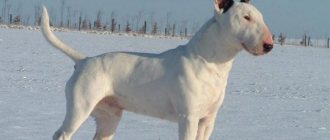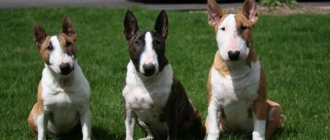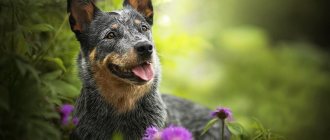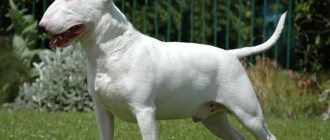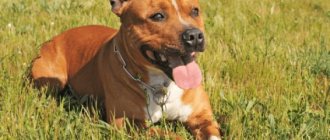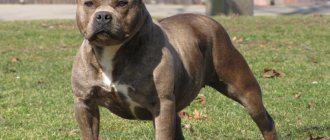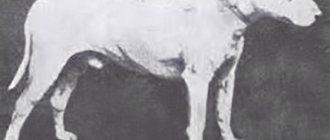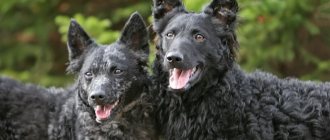A dog's muzzle evokes affection in many people, and it doesn't matter whether it's flat or long. Breeds such as Pugs and Boxers are brachycephalic, meaning the animals have a compact nose and flattened muzzle. Of course, these pets are adorable, but, unfortunately, they often have serious health problems.
There are a large number of dogs with elongated muzzles; they are called dolichocephalic. Mostly, these are greyhounds, which have developed hunting instincts and need space to move.
If you're looking for a long-faced pet, you've got plenty to choose from!
Bull Terrier
In our country, this breed was popular in 1990-2000, but even now you can often find this unusual and somewhat strange-looking dog.
Non-fans often say that the Bull Terrier has a rat's face, but to me he seems like a sophisticated aristocrat, because the birthplace of the breed is England. A socialized and properly raised bull terrier is just a sweetheart, but if you raise him as a fighting dog, you get a real cyborg killer who feels neither fear nor pain. For a long time, a branch of bulls was bred in which their natural aggressiveness was eradicated. Therefore, when buying a puppy, you need to choose the breeder very carefully.
The Bull Terrier is a real fidget. He spins and turns, rushes around the house, the street - it doesn’t matter where. Therefore, he needs to be tired every day: take long walks and exercise him physically. If you don’t give him this, then your slippers, or even your sofa, will suffer. Therefore, it is undesirable for him to live in an apartment. He will bring too much chaos into it. If you leave a boule alone for a long time, then an unbearable howl will be added to the gnawed property, for which the neighbors will definitely say “thank you” to you.
The Bull Terrier perceives other animals either as a rival or as prey. There are cases of livability, but this is rare, and even in this case you should not leave your pets to their own devices. But bulls often do not show aggression towards people. Therefore, their guard is so-so.
Video: bull terrier
Bullmastiff
In England in the 17th and 18th centuries, bullmastiffs tracked poachers on lords' lands. The breed’s excellent sense of smell and watchdog qualities are highly valued in the police and army, and at home it is simply a reliable friend and playmate. The fight for leadership is not in the nature of the bullmastiff, but he has his own opinion about everything in the world, which he stubbornly defends. You can convince a dog only with patience, not brute force!
Photo: mirzhivotnye.ru
Description of the breed
Breeds that are used in fighting fall into a category called fighting dog breeds. There are approximately twenty breeds in the world that take part in this kind of competition. It should be noted that none of the International Canine Organizations recognize the category of fighting dogs. For them, this concept defines the profession, but not the breed of the dog.
The category of fighters has a number of common characteristics: a large head, a well-developed jaw, a massive body and a very menacing bark. A number of Molossians are classified in this category: Alabais, bulldogs, mastiffs, bull terriers and some varieties of Great Danes.
Alabai. A breed endowed with a complex psyche and a unique character. The use of Alabai as fighting dogs in Turkmenistan is a tribute to centuries-old traditions. The only breed that will never finish off an enemy, but will retreat at the first squeal. And, along with this, Alabai is surprisingly gentle and caring towards his own and human children. The main job of this devoted creature is to guard the peace of its owner in any weather and protect his property.
American Bulldog. Takes its roots from the English bulldog. Dogs with a powerful jaw and an iron grip. Initially, they were used for bull baiting, and later in fights against other dogs. Since the fighting qualities of dogs of this breed were not enough, they began to be crossed with various kinds of terriers. As a result of this work, a number of new breeds appeared, but not all of them inherited fighting qualities. And the American Bulldog himself has long forgotten his combat past.
American Pit Bull Terrier. Thanks to the negative media outpouring towards this breed, the pit bull was called the fiend of evil and an idol among fighting dog breeds, becoming the most dangerous creature in the eyes of the public.
In fact, they are one of the most cheerful, loyal and loving breeds on the planet. It simply contains an indomitable desire to please its owner in everything. This is the only breed whose feeling of love for a person is so great that it does not even notice the strong smell of alcohol, although almost all breeds simply cannot stand it.
American Staffordshire Bull Terrier. Another monster of the dog world, so colorfully described by the media. Let us only note that thanks to painstaking selection, the staff has lost its aggression towards living beings.
There are no dangerous breeds! There are very irresponsible owners. If you let upbringing take its course without training, you will definitely end up with a stubborn, unbalanced and disobedient dog. A dog becomes dangerous only with indifferent owners.
Dog with a rat face breed photo ⋆ Online magazine for women
The Bull Terrier breed has received a special status - it is called “the dog with a rat face.” With its appearance, it caused conflicting opinions in the world community. She was prescribed the characteristics of a killer dog and at the same time she was considered a reliable friend and guard.
Origin story
The founder of the breed is the Englishman James Hinks. Thanks to him, experimental fighting dog puppies with an elongated rat muzzle were born. The exterior of bull terriers was formed as a result of 10 years of crossing the extinct breed of white terrier and English bulldog, with admixtures of Dalmatian blood.
The main goal - to get a fearless dog with a high pain threshold - was achieved. The beauty and aesthetics of the animal’s external appearance were not considered.
At the end of the 19th century, the breed was recognized by the English Kennel Club. At the beginning of the 20th century it was allowed to reproduce. Keeping a bull terrier has become a prestigious occupation that emphasizes social status.
Bull Terrier - description
Previously, this breed of dog was used for baiting wild animals and dog fighting. Since the ban on bloody spectacles, the breed has come a long way of socialization and managed to adapt to the requirements of modern people.
The Bull Terrier today is a loyal friend, a cheerful companion and an active athlete. Myths about its mortal danger have been dispelled. He is the embodiment of intelligence, endurance, strength and dexterity. His extraordinary appearance makes him look like a giant rat. The photo of a dog with a rat's face confirms this.
Bull Terrier - a dog with a rat face
Breed standard
The Bull Terrier has an international breed standard, deviations from which are considered a fault:
- The body is athletic, muscular, strong.
- The head is oval, ovoid in shape.
- The muzzle is elongated, arched.
- The neck is strong.
- The jaws are powerful, the compression force is 25 atmospheres.
- The mouth is big.
- The bite of the teeth is cross-shaped.
- The ears are erect, V-shaped, close set.
- The nose is pronounced and large.
- The eyes are small, triangular in appearance, slanted, wide and deep set.
- The tail is short and not docked.
- Average weight 30 kg, not limited by standard.
- Height at withers is from 40 to 55 cm. Males are larger than females.
- Life expectancy is 12-14 years.
Character and education
The nature of the “boules” is specific. They have an extraordinary mind and can read a person’s thoughts. From the first days, it is necessary to extinguish the foci of their aggression and direct the strength and energy of the dogs in the right direction. With proper upbringing of a puppy and its early socialization, a good friend and protector will grow up.
Bull Terriers are hyperactive and require long-term physical and mental training. They are willful and stubborn. They are not characterized by cowardice and betrayal. Ready to protect the owner at the cost of life. Affectionate in the family, loyal to children and powerful in the world around them. Any representatives of the fauna are treated as prey. Walking without a leash is prohibited.
Training
Training a Bull Terrier requires a lot of time and effort. To achieve results, strict and humane methods are needed. Physical punishment is prohibited; the bull remembers insults. These dogs need the strong-willed hand of a competent breeder. Otherwise, you can get an uncontrollable and dangerous animal.
Care and maintenance
In terms of grooming, the Bull Terrier is not difficult, he is clean:
- Brush the coat with a rubber mitten 2-3 times a week, daily during the shedding period.
- Clean your ears once a week.
- Wash your eyes daily.
- After walking, wipe with a damp towel.
- Bath with shampoo as needed.
- Trim the claws.
exclusively domestic, preferably to a family without children. Aviary and chain housing breaks the animal’s psyche and leads to its aggression. The bull is afraid of the cold; at temperatures below -10, walk in clothes. During the hot season, refrain from exposing your pet to the sun.
Diseases
High-quality representatives of the breed have strong immunity. Hereditary diseases include:
- partial or complete deafness;
- loss of vision;
- kidney diseases.
Other diseases arise due to poor care and maintenance (dermatitis, heart failure, pancreatitis).
Origin of the Bull Terrier breed
The homeland of the Bull Terrier breed is Great Britain. For the first time, dogs with an elongated, rat-like muzzle appeared in the middle of the 19th century as a result of many years of experiments. To create the breed, English bulldogs, white English terriers and Dalmatians were crossed. From all these breeds the dog has adopted the best traits - endurance, activity, courage, intelligence.
Maintenance, care
The maintenance of these large pets begins with preparing a place for it, which is not recommended to be changed in the future. Since the Great Dane puppy will grow into a huge dog in the future, he needs a lot of space in the apartment, as well as a lot of free time from the owner for joint activities with the pet. Therefore, if the apartment is small, or all family members are too busy, then it is better not to purchase a Dog.
It is also not recommended to get this particular dog if the novice dog breeder has not previously had experience raising these particular pets. After all, raising and training these huge and sometimes very stubborn dogs requires from the dog breeder not only time, but also skill, as well as strength, patience and a certain character, so that the dog can feel who is in charge in the house.
These pets (due to their large size) require long daily walks. And if the puppy should not be forced against his will to take long walks, then older pets themselves are willing to go for walks with the owner. Moreover, when walking different subtypes of Dogs, it is better to alternate between just walking and jogging. The best place for walking is on hard ground, where the dog can run calmly without knocking its paws.
Great Dane subspecies with long legs can often have joint problems, so you should be careful about the appearance of even mild lameness. Also, such dogs are prone to colds, so there should be no drafts in the place where your pet will rest, and you should also provide him with soft bedding.
You need to bathe your Great Dane when it gets dirty, and you need to brush it daily. It is better to use a special massage brush for this.
Feeding
It is better to feed such dogs homemade food. But it should be remembered that in the spring and summer the diet should contain less food rich in proteins and carbohydrates, but in the fall and winter the amount of such food is increased. As the puppies grow, the amount of food increases in proportion to the dogs' growth.
The puppy at home continues to be fed the same food that he received from the breeder, but gradually you can accustom him to an adult diet. Such large breeds need meat in sufficient quantities, but it is better not to feed chicken.
Upbringing
It is better to start raising such proud and slightly stubborn pets from the first day the puppy appears in the house. The main thing is that the puppy gets used to the owner and trusts him completely.
Important! These dogs are highly intelligent and quickly remember commands. Training puppies should begin with walking on a leash - these dogs do not like this procedure, so they should be taught without shouting, rewarding them for the slightest achievement
Gradual training of a puppy in the rules of behavior in the house and on walks can begin from childhood, but serious training begins no earlier than the dog is six months old. It is better to take the Dog to an experienced instructor at the first stage of training - he will teach the dog basic commands and tell the owner how to practice them correctly at home or on a walk.
Parenting mistakes
Obvious mistakes in education include:
- irregular exercises with the dog;
- intemperance of the owner, practicing commands in a raised voice, frequent assault when the pet disobeys;
- training this large pet in crowded places, if the dog is not yet sufficiently trained.
Breed standard Prague rat
The Prague Rat is a miniature “aristocrat”, at first glance it looks a lot like a Russian Toy and a little less like a Miniature Pinscher. Breeding specialists attach great importance to the body proportions of ratliks, so they have to identify an exemplary representative of the breed, armed with a measuring tape and a calculator. In particular, the ratio of the dog's height to the length of its body should be about 1:1.05. Moreover, the figure indicating the height of the animal at the withers must be at least twice the depth of its chest, measured in centimeters. The width of the rat's forehead in relation to its length is 1:1, less often – 1:1.03, and the length of the muzzle does not exceed ½ the length of the head.
Head
The Prague rat's head is pear-shaped. The occipital protuberance and forehead of the dog are convex, clearly defined, the stop is moderately prominent. The animal's muzzle is distinguished by its general dryness and sufficient length.
Teeth and jaws
The ratlik's jaws are strong, symmetrically set, and shaped like a blunt wedge. A full dentition and scissor bite are preferred.
Ears
Representatives of this breed have wide-set, strong ears, fixed in a standing position and shaped like butterfly wings. It is acceptable, although not very desirable, for the tips of the ear flaps to be lowered at a slight angle to each other.
Frame
The body of the Prague rat is compact, almost square in format, with a moderately selected underline. The back is level, strong, with unpronounced withers and a short loin. The dog's chest is oval and of normal width. The croup line is long, slightly sloping.
The front legs are set parallel and quite wide. The Prague rat's shoulder blades are muscular, well-fitting, the pasterns are even, set at a slight angle. The dog's hind legs are distinguished by a wide, parallel stance, reliable articulation angles and overall muscular contours. The paws of representatives of this breed are rounded, arched, with tightly clenched toes. The dog's movements are free and springy.
Tail
The tail of the Prague rat rat is set at the level of the back, but when moving it rises higher, curling into a ring. The usual length of an undocked tail is to the hocks.
Wool
Prague Rat Dogs can be either short-haired or semi-long-haired. In the first case, the dog’s body is dense and fits well to the body. Secondly, it is softer, slightly behind the body, forming stylish feathering on the paws, ears and tail.
Color
Most Prague rats are black or brown and tan, and the tan should have a rich tone and not be washed out. Typical locations for tan marks are the pasterns, throat, cheeks, eyebrows, inner thighs and chest (spots in the form of two symmetrical triangles). A little less often you can find representatives of this breed of sand and chocolate colors. A marbled coat tone is also acceptable.
Defects and disqualifying defects
The most typical exterior defects of the breed: narrow skull, pincer bite, convex loin and back, depigmented nose, excess tan. White spots on the chest with an area of more than 1 cm, elbows turned in or out, an overly stretched body, a low-set tail that hangs over one of the hips are also not welcome.
Disqualifying vices of Prague rat rats:
- not completely overgrown fontanel;
- hair with receding hairline;
- hunchback and overly convex lower back;
- ears adjacent to the skull;
- undershot/overshot;
- iris of the eye, colored yellow or blue;
- loss of 4 teeth or 2 incisors;
- black and brown and tan individuals have no tan markings on the head;
- a white spot on the chest with an area of 2 cm, white markings on the paws;
- red color, muted by abundant black blossoms;
- height less than 18 and more than 24 cm;
- unreasonable aggression and fearfulness.
Jagdterrier
Nobility and courage are about them.
- Height: 33-40 cm for a male; 28-35 for a female
- Weight: 8-10 kg.
- Lifespan: 13-15 years.
- Color: black, dark brown or grey-tan.
- Coat: medium length, thick. Densely laid over thick undercoat.
Did you know? In 1995, a “dog” record for the length of the swim was set. Labradors Gypsy and Kai, accompanied by their owner, swam 15.2 km (it took 6 hours).
They are easy to train and train, which should be done regularly. Long walks with elements of play (bring a stick or ball) are required, without which the dog will become lethargic or show destructive tendencies.
This terrier will get bored in an apartment, so it is better to keep it while living in your own home. By the way, children will not be the best companions for them (although dogs accept them as “their own”, rushing to help if necessary).
Favorite location is a field where you can chase trophies without restraint, which often ends in a direct fight (brave “yagdas” are not afraid to attack).
Welsh Corgi Cardigan
This breed belongs to small dogs with a long nose. This is a herding dog, famous for its small size and short legs.
Origin
The breed has the following two varieties:
- cardigan - comes from the Welsh county of Ceredigion;
- Pembroke - from the Pembrokeshire county of Wales.
Scientists do not have one general version about the origin of this breed, so the following hypotheses were put forward:
- these dogs came from the northern group, or more precisely from Central Europe;
- these animals come from Ancient Egypt, as images with them were previously found on the statue of Anubis;
- There are rumors that the Cardigan Welsh Corgi was brought to the British Isles by the Celts.
The very first mentions were around the 10th century in written form. In 920, the Welsh king created a set of laws imposing a fine for killing this dog.
Description
A distinctive feature of this animal is its small size and short legs. Weight usually does not exceed 20 kilograms, and height is no more than 35 centimeters. Despite its size, the dog is quite hardy and strong. The skull is wide, the nose is elongated, the ears are large and erect. The jaw and teeth are strong. The coat is medium, the color can be absolutely any. As for the character of the pet and its behavior, it is a rather friendly and active animal. It gets along well with children and cats, and quickly gets used to its owner.
Training
A dog like a corgi is easy to train and train. There are almost no problems with the animal; it copes with the role of a shepherd perfectly.
Nutrition
Before you bring such a friend home, it is important to know that he is very prone to overeating. Monitoring the quantity and quality of food in this case is very important
The Corgi's diet should consist of the following food:
- natural meat or fish;
- dairy products:
- vegetables, cereals;
- natural raw eggs (no more than 3 times a week).
The Cardigan Welsh Corgi lives no more than 15 years. For a longer life, it is necessary to monitor the health of the dog, especially the eyes and ears.
Character and education
The nature of the “boules” is specific. They have an extraordinary mind and can read a person’s thoughts. From the first days, it is necessary to extinguish the foci of their aggression and direct the strength and energy of the dogs in the right direction. With proper upbringing of a puppy and its early socialization, a good friend and protector will grow up.
Bull Terriers are hyperactive and require long-term physical and mental training. They are willful and stubborn. They are not characterized by cowardice and betrayal. Ready to protect the owner at the cost of life. Affectionate in the family, loyal to children and powerful in the world around them. Any representatives of the fauna are treated as prey. Walking without a leash is prohibited.
Let's sum it up
Representatives of the Bull Terrier breed can be briefly described in a few words: strong and dexterous, wise and sociable, loyal and kind. These dogs require early socialization and mandatory training. Suitable for experienced and active owners. You need to know that the bull terrier, like many other dog breeds, will not perceive a nervous and insecure person as a leader, as well as a cruel, offending animal. This dog will submit and respond to care and love, and will be devoted only to those he respects, and such respect must be earned.
Character
There is a misconception about pets of this breed. This rat-faced fighting dog is believed to have a very aggressive disposition. However, this is not the case. By nature, bull terriers are very cheerful, affectionate and loyal. These dogs hate being alone, so they prefer to always be in company. They love to play with children, and anger towards people is absolutely abhorrent to them.
There are probably only a few situations where their stereotypical nickname can be justified. So, when two males meet head to head, each of them begins to want to defend the right to be the leader of the pack. As for females: two or more can easily get along in one company, just like, in principle, a female and a male.
Also, bull terriers are fighting dogs, which means they have a desire to win in their blood, so when they see cats and other living creatures, they can lose control of themselves. As a result, keeping two different pets in the house becomes a very risky decision.
Sometimes, due to their nature, Bull Terriers can try to insist on their own, but with proper training they become obedient companions.
Thanks to the strength of the Bull Terrier, dogs are excellent running partners and other sports activities.
Afghan Hound
What are the names of dog breeds with a flattened muzzle?
Unlike the giants described above, although Afghan hounds are tall, they look unusually elegant and graceful. This is the oldest breed, the history of which goes back thousands of years. Afghan hounds are excellent hunters, but in ancient times the dogs were used to guard homes and herd livestock.
Afghans are difficult to train, but not because of their natural narrow-mindedness and low intelligence. On the contrary, dogs are smart and quick-witted, but their stubbornness and arrogance sometimes cross all boundaries.
That is why the breed is not recommended for inexperienced dog breeders. Training may take more than one year, and the process will require considerable patience and endurance from the owner.
These long-haired aristocrats are suitable for exhibitions and show programs. Surely, dogs love to show off!
How to keep and care for a Bull Terrier
The breed is a smooth-haired dog, so you won’t need any complicated care. Your pet may shed twice a year. Wool can be easily removed with a brush or a special mitten.
After walks, you don’t need to bathe your dog; just wipe it with a sponge or damp towel.
Check your ears and eyes regularly for inflammation. Whites may have hearing problems. There are cases when puppies are born deaf.
The Bull Terrier's mobility indicates that it really needs to be exercised. Therefore, active walks, playing with a ball, jumping over the bar - all this is necessary to maintain the good physical condition of the dog. After such walks, the dog will be calm and docile. And with insufficient loads, don’t be surprised why he goes crazy and turns everything upside down.
Dog food
What to feed a bull terrier? Such a powerful, muscular and energetic dog must be well fed. It is best to opt for specialized food with a balanced composition, which contains the required amount of proteins and carbohydrates, vitamins and microelements.
Contrary to popular belief, you should not feed your Bull Terrier only meat. The daily diet should contain the following products:
- 60% meat;
- 20% cereals;
- 20% vegetables.
In addition to beef and chicken, it is allowed to feed your pet sea fish fillet and offal. You can also give fermented milk products: sour cream, cottage cheese.
Gampr (Armenian Wolfhound)
This breed is quite large and looks powerful, its height is about 64-68 centimeters, but there are specimens that are about 90 centimeters. The dog's weight varies between 49-64 kilograms, a significant part of it falls on the wool. The muscles are well developed, the body is quite massive, the chest is wide. The ears hang down, the eyes are dark, there are sloping brow ridges, making the look look friendly. The color of this breed varies, most often it is sandy, but the muzzle is always black or gray. The coat is long, the tail does not lie on the back even in a state of excitement.
Gampr is a kind and caring dog, she does not like fuss and clearly follows commands. She usually shows a reverent attitude towards children and remains neutral towards other animals. The dog behaves calmly during training and appreciates encouragement.
to contents ^
Raising a puppy
The Bull Terrier is a hyperactive dog, so you need to start training your puppy from the first days of his arrival in your home. The new resident should have a place to rest, a designated place for food, where there should be bowls for food and water.
View gallery
First of all, the owner must make it clear to the baby that he is the master of the house. You cannot follow the puppy’s lead, allowing him to climb onto the sofa or beg at the master’s table. Small bull terriers are very smart. They quickly understand that they cannot take food from strangers or pick it up from the ground, etc. If you understand that you cannot raise a puppy on your own, contact a professional dog trainer.
Spanish Mastiff
Even among the huge Molossians, the Spanish Mastiff looks like a hero - males reach a weight of 120–130 kilograms. The dog is fully aware of its power and does not stoop to petty squabbles, but will not offend its owner. The Spanish Mastiff is strict and cold with strangers, but around the family it is cheerful and playful. And the impregnable giants adore children and forgive the little naughty ones absolutely everything!
Photo: zverushki.media
Medium dog breeds: names and photos (catalog)
Dogue de Bordeaux
Despite its massiveness and healthy appearance, this is a sickly breed that requires regular preventive examination by a veterinarian. A healthy and caring Dogue de Bordeaux will become a faithful companion and reliable protector.
Curiosity and activity are qualities that are not characteristic of this dog. He almost always behaves with restraint, concentration and calm. There is little that can provoke him into a strong display of emotions.
If a stranger comes into the territory of the Dogue de Bordeaux, he begins to bark loudly, thereby attracting the attention of his owner.
Despite the lack of excessive activity, you should not put your dog on a chain. This will make her unhappy. She really needs to communicate with her owners and loves scratching and other tactile contacts.
The appearance of the animal is unusual. It has thin red fur, drooping cheeks, long floppy ears and a wide mouth. Due to the large number of skin folds on the face, the dog looks sad.
Dogue de Bordeaux is ideal for owners who lead a sedentary lifestyle and prefer to spend most of the day lying on the couch with their beloved pet.
How to keep and care for a Bull Terrier
A dog with a hooked nose, like other pets, requires proper care. In spring and autumn there is heavy molting. At this time, you need to pay more attention to combing, which requires a special brush and a rubber mitten. During other periods, the frequency of combing is 2-3 times a week. The pig-faced fighting baby needs to eat regularly to gain energy.
Hygiene procedures should be carried out regularly. They are as follows:
- you need to clean your ears every week;
- trim nails regularly;
- wash your dog with special shampoo as needed;
- Rinse your eyes daily, otherwise inflammation may develop.
The Bull Terrier needs active walks, games with a ball and sticks. Due to its short fur, the dog cannot tolerate extreme cold. Therefore, you need to wear special clothes. In summer, it is recommended to spend more time in the shade.
Note! Bull Terriers extremely rarely suffer from ear diseases, but problems with hearing can occur, especially in white individuals. Many are born completely deaf
Summer walks should be active. Therefore, it is recommended to lengthen the leash when your pet is walking in the park. You need to purchase a sufficient number of toys: balls, rubber bones, flying saucers. If the walk is less active, the dog will be nervous and take out its energy on things in the house.
This dog must be trained using only humane methods. If you use physical force, there is a possibility of provoking aggression. Do not forget that the dog has a fighting spirit. At the same time, training takes a lot of time and effort, and it is often carried out exclusively by a specialist. The pet must understand that the owner must be in charge, only in this case will he unquestioningly fulfill all requirements.
Body type
When examining a dog with a pig's muzzle, what immediately catches your eye is that it has a powerful and muscular body and a rounded chest.
The limbs are muscular and strong. With a massive body, the pit bull pig is very agile and agile. The peculiarity is that the dog has strong jumping ability. The fighting pet constantly runs around due to the large amount of energy.
Useful tips
Since rat-faced dogs have very colorful genetics, they require proper care and supervision.
It has been said more than once about the physiological characteristics of the breed, because bull terriers definitely need constant physical activity. If there are not enough of them, the pet begins to look for other outlets for energy, which affects the character of the animal. Another extreme that a lack of exercise can lead to is laziness and, as a result, a gain in fat mass.
For good moral health, the pet must feel that he is loved and important, but at the same time, care should be taken to ensure that the bull knows who remains in charge in the house.
The rat-faced fighting dog is just as possessive as its terrier cousin. Therefore, teasing an adult should not only not be done, but is completely prohibited. Behavior in the form of taking away toys and claiming his property will cause a flurry of justified aggression in the dog.
From a very early age you should:
- to accustom him to the fact that everything around him belongs not only to him;
- show your dissatisfaction with all your appearance when the puppy has an outburst of aggression;
- do not indulge your pet’s whims;
- reward a completed command with treats or verbal praise;
- if the command fails, do not pour a mountain of abuse on the bull, and especially do not physically harm him.
If the owner has a balanced character and a persistent disposition, he has every chance of raising a safe pet both for the home and for society.
American Staffordshire Terrier (Amstaff)
A tireless athlete, a brilliant intellectual and a good-natured cheerful fellow - this is the impression a well-mannered Amstaff makes. Staffordshire Terriers are easy to train and try their best to please their owner. Sometimes it seems as if the dog reads minds! But the motivation should only be positive - violence and rudeness spoil the character of the animal.
Photo: aliexpress.ru
Bull Terrier – Gladiator in a White Tailcoat
England is considered the birthplace of all rat-faced dogs. This breed was developed by James Hincks. Back in the 19th century, he introduced everyone to a white dog with an ordinary appearance. After some time, a fighting bull terrier of a different color appeared. Several completely different breeds took part in the selection:
- English bulldog;
- Dalmatian;
- white English terrier.
Bull Terrier dog
For many years it was believed that keeping a house of this breed was a sign of good taste. The rat-like dog was a huge success among almost all dog breeders in England. The breed standards are as follows:
- muscular torso;
- height up to 55 cm;
- weight up to 30 kg;
- long elongated head with a shark mouth;
- powerful jaws;
- small tail;
- a big nose.
The color can be varied, but most attention is paid to white wool. A dog with a muzzle like a rat, despite its muscular build, has sufficient agility and can jump high
Head structure
Almost immediately, a dog with a rat's face catches the eye due to the unusual egg-shaped head. Many people find her attractive. The features are as follows:
- the muzzle immediately catches the eye due to the powerful jaw, the teeth are very strong;
- the head is set low on a muscular and strong neck;
- The ears are triangular and erect. They are located quite close to each other;
- the nose is large. Many people argue that a dog with a long nose resembles a rat and is therefore unattractive;
- The eyes are very small and set wide apart, which is why many people think that the dog looks like a pig.
Note! A pit bull with a sharp muzzle is not an elegant dog. The dog's habits look unusual due to its massive body and interesting face.
Coat and colors
Pit bull terriers or pit bulls must be white in color according to the standards. Skin pigmentation largely determines a dog's attractiveness. In addition, wool can be of other shades:
- red color without any markings. In this case, shades can differ significantly, even dark brown;
- black color is less common than others;
- Two-color bull terriers differ from others in that they have large areas of contrasting color. There are a variety of combinations, for example, black and red. White patches spread over the face, paws or chest. Ideally, they should account for no more than 50% of the color;
- There is also a three-color color variant. It is represented by a combination of black, red and white. In most cases, a black tint predominates; white should be no more than 50%. The red color accounts for the least, it appears on the muzzle or chest, as well as on the limbs.
- brindles were not immediately recognized, but eventually they began to be considered at exhibitions. The color of such a dog is represented by a combination of red and dark stripes. In some cases there are white markings.
miniature pinscher
Cat breeds with a flattened face
Initially, miniature pinschers were bred by German peasants to guard stables and houses, catch rodents and hunt small animals. Dog handlers became interested in small, energetic dogs towards the end of the 19th century.
After the first standard was issued in 1880, miniature pinschers spread to cities and became lap dogs. In everyday life they are called dwarf pinschers.
Miniature pinschers are slender dogs with well-developed muscles, 25–30 cm tall.
The high-set ears of miniatures are directed upward or hang down on the cartilage. The smooth coat fits tightly to the body and shimmers in the sun.
The miniature pinscher's gait resembles that of circus horses. The dogs gracefully raise their forelimbs and gently lower them in front of them.
Active, inquisitive miniature pinschers love to explore the territory, learn new things, and are easy to train. They are friends with school-aged children. They do not have enough gentleness and patience to communicate with children. Miniature pinschers have not lost their instincts as watchmen and guards.
